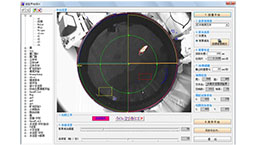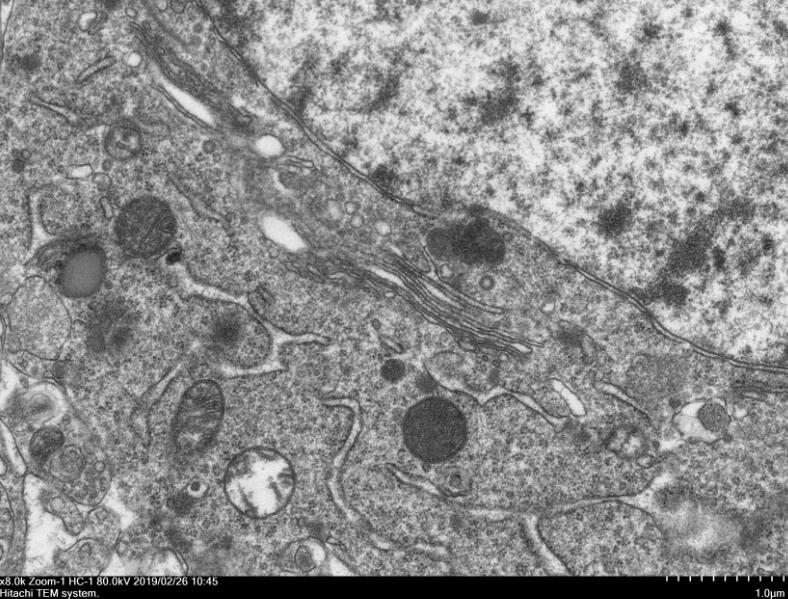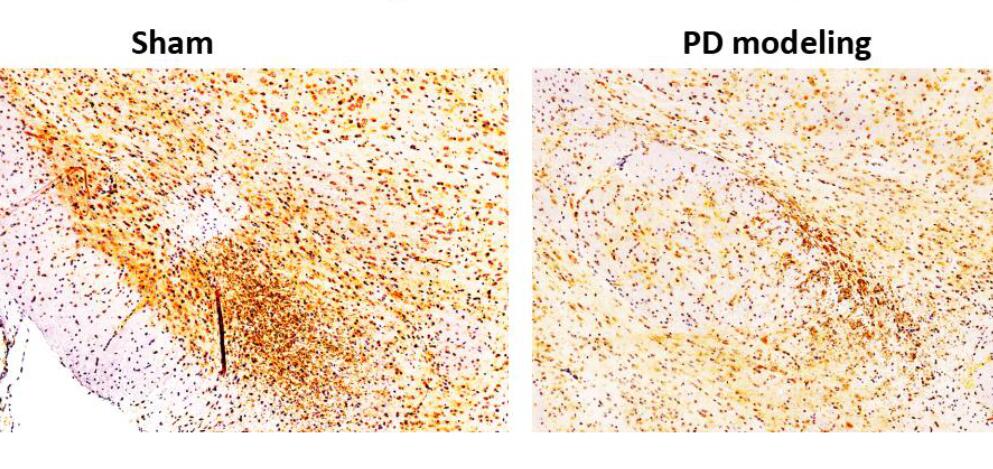Mouse Model for Parkinson's Disease (PD)
- Product No.DSI710Mu02
- Organism SpeciesMus musculus (Mouse) Same name, Different species.
- Prototype SpeciesHuman
- SourceInduced with MPTP
- Model Animal StrainsBalb/c Mice(SPF), healthy, male, age: 4~6weeks, body weight:18g~20g.
- Modeling GroupingRandomly divided into six group: Control group, Model group, Positive drug group and Test drug group.
- Modeling Period4-6 weeks
- Modeling MethodModel modeling method:
MPTP was intraperitoneally injected 20mg/kg/d for 14 consecutive days. The control group was intraperitoneal injection with equal volume of normal saline, and the operation and precautions were the same. After MPTP administration, the model was established successfully.
Drugs to be treated with appropriate drugs; The normal group and PD model group were intraperitoneal injected with equal volume PBS, and the operation and precautions were the same. - ApplicationsDisease Model
- Downloadn/a
- UOM Each case
- FOB
US$ 200
For more details, please contact local distributors!
Model Evaluation
1. Rotarod experiment: The mouse RotaRod System was used to test the motor coordination ability of the mice.
Mice were placed on a rotating rod with a diameter of 3cm and the rotation speed was adjusted to 30r/min. 5 mice were measured at the same time, 1 in each compartment. The time from the beginning of the rotation of the rotating rod to the dropping of the rotating rod was recorded. The measuring time was 1min, and each time the mice took a 1min rest. The Times of dropping within 1min were recorded for 5 consecutive times.
2. Open field test: that is, spontaneous activity, which is a common indicator to detect less movement after MPTP injury.
The size of the experimental chamber used in the open field experiment is 500×500×300mm, the color of the surrounding wall is black, and the bottom surface of the open field is divided into 16 4×4 squares on average. A camera is mounted directly above, covering the entire field. The animal was placed in the central grid, and the camera was shot and timed at the same time for 5 minutes. The computer tracer analysis system is used to analyze the activity of animals in a certain period of time. The laboratory is kept quiet, the room temperature is about 20 ℃, and there is plenty of light. Observation indicators: the number of times of crossing between squares (the animal's limbs entering from one square to another is once crossing), the number of upright positions (the animal's forelimbs leaving the ground at the same time, or placing both forelimbs on the wall counts as one upright position), the stay time of the central lattice, and the number of crossing the central lattice.
3. Pole climbing experiment: it is a classic method to evaluate the motor coordination ability of mice. Locomotion was compared by recording the time it took the mice to move from the top of the pole to the bottom (with both forepaws on the ground). Placed in mice in the experiment on A rough wooden balls, the bottom has A rough surface and cross-section as the round rods, lower rods placed in the cage, when the mouse upside to stick to climb from wooden balls below, with A stopwatch to record this moment of time is A, when its climb to stick the bottom, record this moment of time as B, Then the time for the mouse to climb the whole stick is C, C= A-B, and each mouse is tested twice. The average time of the two times to climb the rod is taken as A statistical indicator.
Pathological Results
1. Staining of brain tissue with Nite
The brain tissues of mice in each group were fixed with fixed solution, embedded in paraffin, sectioned and stained with Nisslei bodies. The number of Nissnei bodies in brain tissues of each group was observed.
2. The expression of TH in substantia nigra was detected by immunohistochemistry
The brain tissue sections of each group of mice were repaired to the substantia nigra for immunohistochemical staining for the expression of tyrosine hydroxylase.
3. Ultrastructure of dopaminergic neurons in mouse brain was observed under electron microscope. In the low power field, the cell structure was basically complete, while in the high power field, there was a close-up of mitochondria. Iron-dead mitochondria could be seen in the MPP group: the size of iron-dead mitochondria decreased, the density of bilayer membrane increased, the outer membrane broke, and the ridge decreased or disappeared.
Cytokines Level
Statistical Analysis
SPSS software is used for statistical analysis, measurement data to mean ± standard deviation (x ±s), using t test and single factor analysis of variance for group comparison, P<0.05 indicates there was a significant difference, P<0.01 indicates there are very significant differences.
GIVEAWAYS
INCREMENT SERVICES
-
 Tissue/Sections Customized Service
Tissue/Sections Customized Service
-
 Serums Customized Service
Serums Customized Service
-
 Immunohistochemistry (IHC) Experiment Service
Immunohistochemistry (IHC) Experiment Service
-
 Small Animal In Vivo Imaging Experiment Service
Small Animal In Vivo Imaging Experiment Service
-
 Small Animal Micro CT Imaging Experiment Service
Small Animal Micro CT Imaging Experiment Service
-
 Small Animal MRI Imaging Experiment Service
Small Animal MRI Imaging Experiment Service
-
 Small Animal Ultrasound Imaging Experiment Service
Small Animal Ultrasound Imaging Experiment Service
-
 Transmission Electron Microscopy (TEM) Experiment Service
Transmission Electron Microscopy (TEM) Experiment Service
-
 Scanning Electron Microscope (SEM) Experiment Service
Scanning Electron Microscope (SEM) Experiment Service
-
 Learning and Memory Behavioral Experiment Service
Learning and Memory Behavioral Experiment Service
-
 Anxiety and Depression Behavioral Experiment Service
Anxiety and Depression Behavioral Experiment Service
-
 Drug Addiction Behavioral Experiment Service
Drug Addiction Behavioral Experiment Service
-
 Pain Behavioral Experiment Service
Pain Behavioral Experiment Service
-
 Neuropsychiatric Disorder Behavioral Experiment Service
Neuropsychiatric Disorder Behavioral Experiment Service
-
 Fatigue Behavioral Experiment Service
Fatigue Behavioral Experiment Service
-
 Nitric Oxide Assay Kit (A012)
Nitric Oxide Assay Kit (A012)
-
 Nitric Oxide Assay Kit (A013-2)
Nitric Oxide Assay Kit (A013-2)
-
 Total Anti-Oxidative Capability Assay Kit(A015-2)
Total Anti-Oxidative Capability Assay Kit(A015-2)
-
 Total Anti-Oxidative Capability Assay Kit (A015-1)
Total Anti-Oxidative Capability Assay Kit (A015-1)
-
 Superoxide Dismutase Assay Kit
Superoxide Dismutase Assay Kit
-
 Fructose Assay Kit (A085)
Fructose Assay Kit (A085)
-
 Citric Acid Assay Kit (A128 )
Citric Acid Assay Kit (A128 )
-
 Catalase Assay Kit
Catalase Assay Kit
-
 Malondialdehyde Assay Kit
Malondialdehyde Assay Kit
-
 Glutathione S-Transferase Assay Kit
Glutathione S-Transferase Assay Kit
-
 Microscale Reduced Glutathione assay kit
Microscale Reduced Glutathione assay kit
-
 Glutathione Reductase Activity Coefficient Assay Kit
Glutathione Reductase Activity Coefficient Assay Kit
-
 Angiotensin Converting Enzyme Kit
Angiotensin Converting Enzyme Kit
-
 Glutathione Peroxidase (GSH-PX) Assay Kit
Glutathione Peroxidase (GSH-PX) Assay Kit
-
 Cloud-Clone Multiplex assay kits
Cloud-Clone Multiplex assay kits
| Catalog No. | Related products for research use of Mus musculus (Mouse) Organism species | Applications (RESEARCH USE ONLY!) |
| DSI710Mu03 | Mouse Model for Parkinson's Disease (PD) | n/a |
| DSI710Mu04 | Mouse Model for Parkinson's Disease (PD) | n/a |
| DSI710Mu01 | Mouse Model for Parkinson's Disease (PD) | n/a |
| DSI710Mu02 | Mouse Model for Parkinson's Disease (PD) | Disease Model |
| TSI710Mu15 | Mouse Brain Tissue of Parkinson's Disease (PD) | Paraffin slides for pathologic research: IHC,IF and HE,Masson and other stainings |








